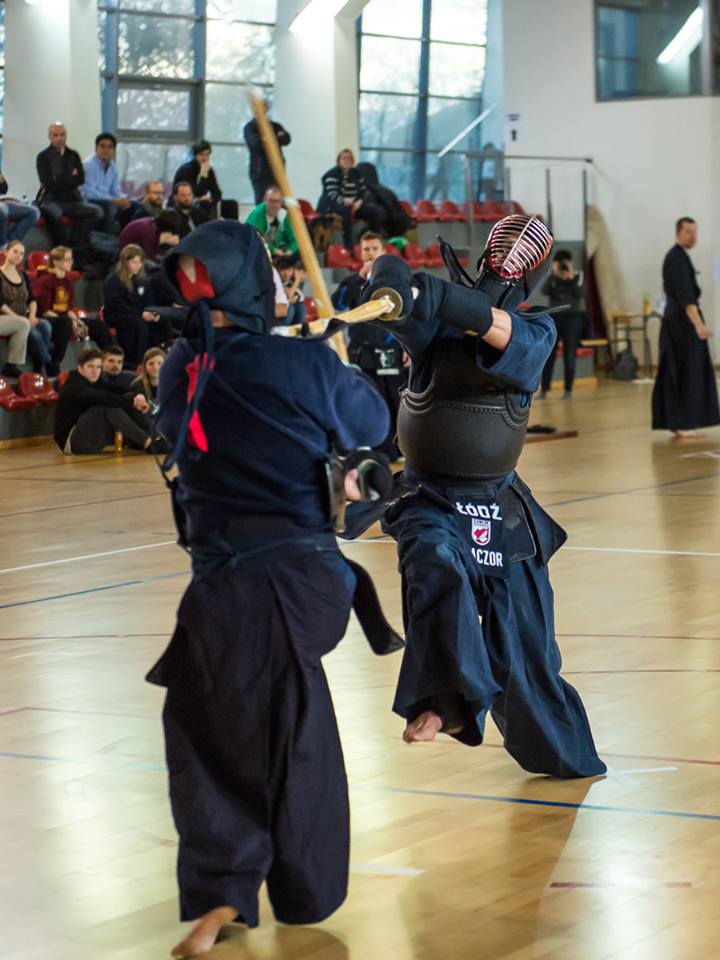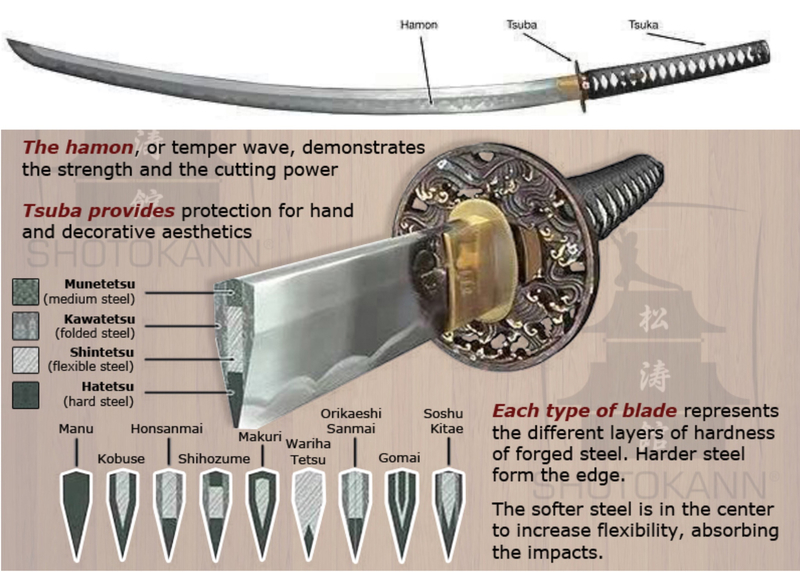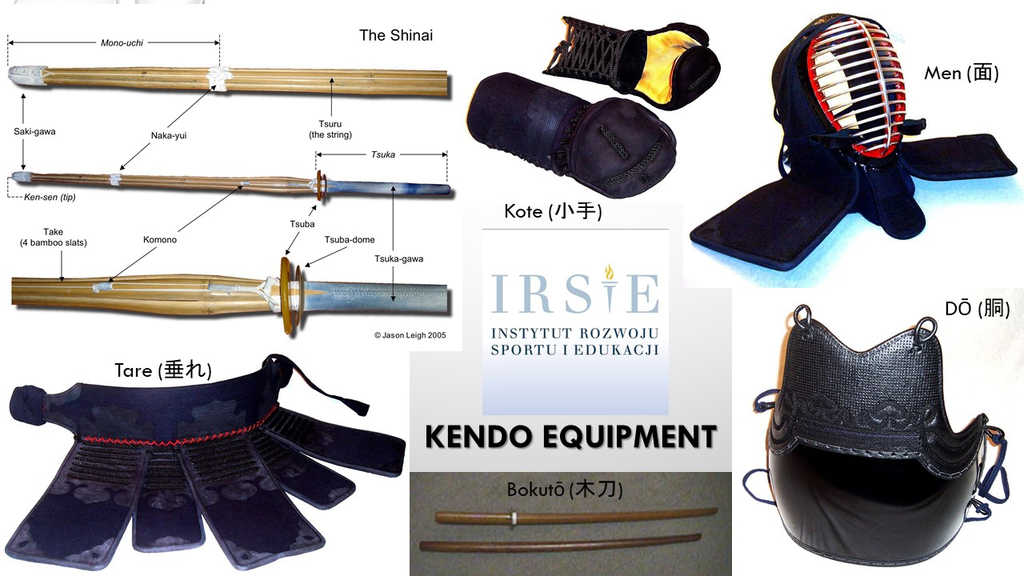
Kendo (Japan)
- Name of sport (game): Kendo
- Name in native language: 剣道
- Place of practice (continent, state, nation):
Japan, practiced worldwide
- History:
Kendo is a martial sport derived from martial art – combat fencing called kenjitsu. Kenjitsu had been practiced in Japan since the introduction of a single-edged sword with a curved shape in the XI-th century. Many schools and various forms of Kenjitsu had been created before the swordsmanship lost its practical character in the second half of the nineteenth century. In 1868, civilians in Japan were banned to carry swords by an imperial edict, and in consequence swords stopped to be used for armed combat and duels. The origins and historical development of real fencing art are described in detail on the pages entitled kenjutsu and iaido.
The para-sport form of combat fencing was born in the early XVII century. Devices allowing infliction of blows were gradually introduced to the practice of fencing. This allowed a practice of contact technique and bloodless fights. The sharp steel swords used before only allowed repeating formalized routines called “kata”, in which blows were stopped in the final phase of the attack. The use of training swords, first wooden, later flexible bamboo structures, and solid protectors inspired by Samurai armor, allowed a more dynamic practice and fight sparring.
Chuta Nakanishi, creator and teacher of the well-known Tokyo fencing school- Nakanishi Itto-ryu, made the greatest contribution to the construction of safe equipment and its popularization among the practitioners. Master Nakanishi is also considered the creator of the name "kendo", where “ken” means "sword", while “do” indicates "way, procedure". Both Japanese characters should, therefore, be understood as "the way of the sword".
Over time, regulations were introduced to the practice, which gradually evolved towards limiting the acceptable area of cutting, as well as eliminating techniques that might cause risk for the fencers.
When the imperial act forbidding the swords and eliminating the social class of bushi warriors was introduced it seemed that the art of sword fighting would completely lose its practical value. It resulted in a decline of kendo popularity for a short period of time. After 250 years of voluntary isolation, the country was forced to open its borders and to confront foreign powers. Japanese society, having recovered from the initial amusement with the technical achievements of the world of that time, felt the danger threatening it and quickly returned to the traditional values. One of them was kendo, not in a military sense, but as a way of education through hard training and self-discipline. The kendo practice was first introduced in police forces, then gradually expanded.
Dai Nippon Butokukai - an organization aimed at reconstructing and taking care of traditional martial arts was established in 1895. A unification of very diverse forms and development of universal practice was required. Kendo was unified in 1912 which allowed its introduction to the curricula as a part of physical education class. Within a short time kendo training and tournaments spread throughout the country. These years are considered to be the birth time of the modern sport of kendo.
The samurai sword - katana - had been used much longer as a military symbol. Until the first decades on 20th century it was still considered an adornment and privilege of the officer's status, similarly as it was in many other armies of the world. However, only the Japanese made real use of their swords. The fact that swords were used not only for seppuku (ritual suicide) but also for the execution of prisoners of war, has earned the Japanese fencing a very negative opinion worldwide.
During the American occupation the Japanese were banned from practicing any of the traditional martial art since they were perceived as a source of Japanese chauvinism. Only after a dozen of years it was possible to convince the world’s public oppinion that modern sport version of Japanese martial arts had features allowing versatile physical development as well as outstanding moral and educational qualities. In 1952 kendo exercises were reintroduced in the school program, first in a pure sports version of shinai kyogi, later enriched with elements of traditional fencing. In the 1950s and 1960s, kendo appeared in the USA, Canada and Brazil thanks to Japanese emigrants. In the mid-1960s it came to Europe, firstly to France, Germany and Great Britain.
The first major international tournament took place in Tokyo in 1967. Two years later the European Kendo Federation was founded. The International Kendo Federation, a union of 15 organizations from all over the world, was founded in 1970. Kendo was brought to Poland in 1973 by a Japanese student, Takao Mizushima. In the Millennium Year 2000, IKF (the International Kendo Federation) brought together nearly 40 countries. The world championships (every 3 years) and the European championships are held. Nowadays kendo is considered a modern international sport discipline.
(Source: Polish Kendo Association: www.kedno.pl) - Description:
Kendo (the way of sword) is a Japanese variation of fencing sport practiced with a bamboo sword. This movement has a centuries-old tradition in Japan. At the beginning of the twentieth century it became well known worldwide thanks to the Japanese emigrants. It became popular in Europe and in Poland in the second half of the twentieth century.
Clear definition of goals is a characteristic kendo feature. This allows the practice of kendo could last for a lifetime and it have impact on all aspects of human psyche. The fight (competition) is not the purpose of the practice but a way to shape the personality. A very concise definition of this discipline has been created: Kendo is a way to strengthen one’s character by applying the rules of sword fighting.
The All Japan Kendo Federation described the purpose of practice as follows: "Everyone should practice kendo in a conscious and sensible way, shape the mind, spirit and body through accurate and rigorous training, respect others and remember to be polite, honest and honorable. This is the constant development of the human character - because only then can you truly love your nation and your homeland, take care of the development of the society and strengthen peace and prosperity all over the world."
Learners are prepared for the contact fencing fight during the training. The rules of this fight are created to protect the fighters from the injuries. Additionally, solid protectors, expressly designed for the purpose of protecting the body from injuries, are used. Secondly, the hit area (cuts and thrusts) is limited to a few areas, like head, forearm, torso, and neck, covered by protectors. Thirdly, the method of points calculation for the hit and the behavior of players during and after the attack is meant to secure the safety of the fencers This way accidents are avoided but the spontaneity of the attack is not limited. Young players (up to 16 years old) are forbidden to use a thrust in the protected neck area.
The training and fight are regulated by a special code of ethics, which controls the behavior and guarantees the safety of the fencers. Learning of the technique and tactics of the fight is quite difficult due to the direct and full-contact attack. It requires a lot of attention and effort from the learners and proper practice organization from the instructor. As a result, kendo training is held under direct and permanent control of the instructor and all parts of the training are preceded by appropriate commands in Japanese. The use of Japanese nomenclature generalizes the message and enables smooth communication during international trainings and competitions, at the same time being a nod to the kendo homeland.
Importantly, kendo is a coeducational sport, which can be practiced together by men and women. The success in competition depends on the technical skills of the fencer, not on their physical strength. Kendo, like the European fencing, allows a very dynamic fight without a risk of injury. A study conducted at the Imperial University of Kyoto in 1992, revealed that kendo is one of the sports with the lowest contusion rate.
Kendo is practiced by circa 6 million of people, 3.5mln of which outside of Japan, mainly in the USA and Europe. Kendo is a sport which can be practiced regardless of age, sportsmanship and gender.
- Current status:
Sport practiced
Despite its strong national roots, kendo is nowadays an universal sport discipline known worldwide. European Kendo Federation (EKF) was established in 1969 while the International Kendo Federation (IKF) - bringing together 50 countries, has been operating since 1970. In Poland kendo has existed since 1973. Currently under the aegis of Polish Kendo Association there are about 800 learners of kendo, iaido and jodo in forty-two clubs (dojo). - Importance (for practitioners, communities etc.):
Ozawa Hiroshi - Kendo, Diamond Books, Bydgoszcz 2000
Paul Budden - Nihon kendo kata, Diamond Books, 2003
Jinichi Tokeshi - Kendo. Elements, rules and philosophy , Diamond Books, 2008
All Japan Kendo Federation (ZNKR) - Fundamental Kendo, Japan Publications, Tokyo 1974
All Japan Kendo Federation (ZNKR) - Kendo Fundamentals, Vol.1 - Kendo equipment, courtesies, basic movements, etc., Tokyo 1994
All Japan Kendo Federation (ZNKR) - Kendo Fundamentals, Vol.2 - Personal attack and defense skills, Training Methods, etc. Tokyo 1994
All Japan Kendo Federation (ZNKR) - Japanese-English Dictionary of Kendo, Tokyo 1996
Toshinobu Sakai - A Bilingual Guide to the History of Kendo, Toshinobu Sakai and Alexander Bennett NP, 2010 - Contacts:
Polish Kendo Association - http://www.kendo.pl
The European Kendo Federation - http://www.ekf-eu.com
International Kendo Federation - http://www.kendo.or.jpPrepared by: Włodzimierz Małecki
The information of the Polish Kendo Association was also used - Sources of information :
- Gallery:

